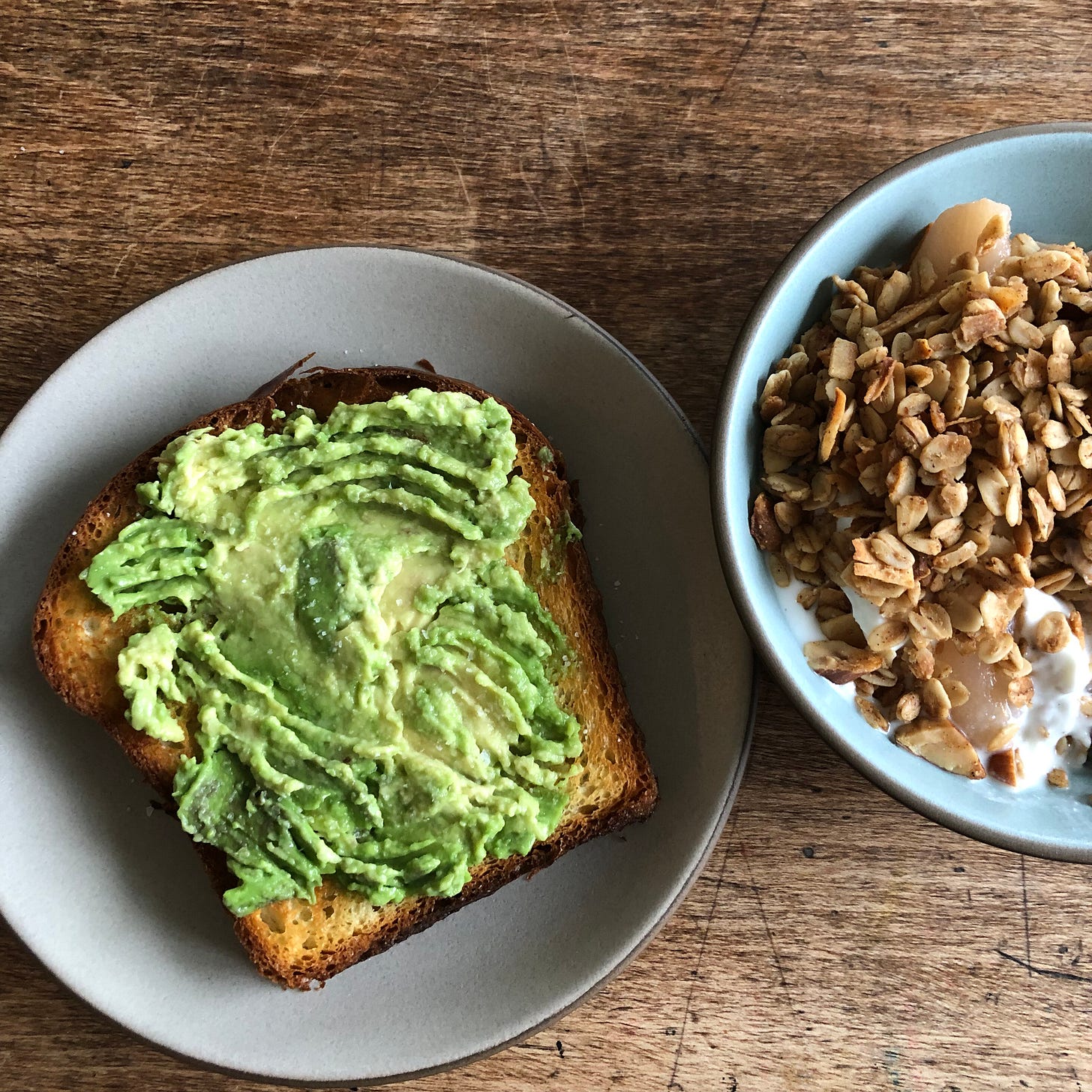Three Strategies for Resisting a Loud Inner Editor
Awkwardness and Fluency, Space for Chaos, Gradual Accumulation, Peter Elbow, Gregory Orr, Carl Phillips, Coconut Maple Granola, and Bemidji, Minnesota
Hi Friends,
Hello from Bemidji, Minnesota, where I’m temporarily a student again in a nonfiction workshop with Lia Purpura as part of the Minnesota Northwoods Writers Conference. I’m here with Anna, a friend I met over twenty years ago when she lived down the hall during my first year of university. Even though we met at university, this is the first time we’ve taken a class together! It’s so sweet to have a person I feel entirely at ease with as I enter a context where everyone else is new. In the morning, we wander down to the dorm kitchen like it’s 1999, and she adds milk to the tea, and I slice the mangos, and she scoops the yogurt, and I pour the granola, and then we slip out to sit and eat by the lake.
Dealing with a Loud Inner Editor
A while back, Marisa (who sends a terrific book notes newsletter1) asked if I had thoughts on how to deal with a loud inner editor. She wrote:
In my own writing life, I feel the greatest challenge is the loud editor's voice in my head, critically examining my word choices and syntax, expressing frustration when the thought is unclear, almost putting a stop to the whole endeavour before I even really begin. It's hard! I've been trying to approach writing with curiosity and playfulness, and it sometimes works, but all this to say, I'm enjoying and looking forward to more writing advice!
This is something I’ve thought a LOT about. I’ve grappled with intrusive and noisy mental editors across genres, from poems to scholarly articles. And I see so many students get tripped up here too, typing and deleting, writing and rewriting.
Here’s where I’ve landed: I can have interesting ideas. And I can make things look pretty. But when I feel pressed to do both at the same time, I’m setting myself up for unnecessary pain. The more I can set up discrete phases for 1) creating and exploring without judgment, and 2) analyzing, arranging, and tidying without pressure to create (or even solve big gaps or issues)—and the clearer I can be about which mode I’m in—the more I’m able to find pleasure in writing.
But as Marisa notes, we can try to bring curiosity and playfulness to early drafting and still find ourselves picking and pausing. And sometimes saying “I’m in the drafting phase! It doesn’t have to be good yet!” just isn’t quite enough to silence that inner editor.
So I have several different frameworks I turn to. When one doesn’t work, another might.
#1 Moving Through Awkwardness Into Fluency
In Writing Without Teachers, Peter Elbow discusses some differences between speaking and writing: “Writing has the advantage of permitting more editing. But that's its downfall too.” Elbow talks about how we pause to edit out awkwardness, wordiness, and errors and how pausing to deliberate and correct may not serve the writing. In contrast, he invites us to remember times when we’ve struggled to speak but still kept going:
. . . think for a moment about the occasions when you spoke well. Seldom was it because you first got the beginning right. Usually it was a matter of a halting or even a garbled beginning, but you kept going and your speech finally became coherent and even powerful.
We get to this “coherent and powerful” speech not by stopping and starting over but by continuing through the stumbling until something comes together, gains momentum. Sometimes this reminder is the permission I need to continue, to trust what might be reached if I allow myself the writing equivalents of throat-clearing and false starts.
#2 Making Space for Chaos and Disorder

Elbow notes that when we edit too soon, we often tidy up not only errors and infelicities but also “unacceptable thoughts and feelings.” This view is core to Gregory Orr’s discussions of process in A Primer for Poets and Readers of Poetry. In brief, Orr writes that poems need both chaos and pattern, and that their power—and our pleasure in them—comes from this negotiation: unruly feelings arranged in patterns of line or rhyme, unspeakable mysteries shaped and held (imperfectly, and temporarily, but still held).
Orr notes that we’re accustomed to repressing disorder or disturbance (mess, chaos, uncertainty) in order to function in daily life. For our writing to have power, however, we need to resist this tendency. Here’s how Orr puts it:
. . the poet has to let disorder in, give permission to let chaos happen—she must permit herself to write down on the page what might seem jumbled and crazy or out of control (Dionysus), trusting that Apollo will come along with a new ordering beyond what the poet’s self could have predicted or forced into being. Thus, first we must give ourselves over to the confusion of our early drafts. But I don’t just mean confusion about plot or anything structural: I mean a deeper confusion of letting ourselves feel disorder, allowing ourselves to put anything and everything down on the page in the hopes of letting some significant disorder enter our process of creation.
This is another framework I’ve found valuable (and not just for poetry). I’m making space for disorder, I tell myself when I try to type without stopping or follow a digression I’m not sure connects. I’m open to being surprised. I can arrange it later. Not just “mess is ok,” but yes, mess, you’re the life that’s needed, the way something new can happen.
#3“An Evening When I Think I’ve Collected Enough”: Trusting Gradual Accumulation
This third framework stands in contrast to the others. While Elbow and Orr both advocate a kind of feverish freewriting—just keep the pen moving, just let it go where it will—another approach might be to jot down bits and pieces, words and images, fragments and phrases slowly over time. Let things accrete. Be receptive. I sometimes call this “sneaking up on a project.”
In a recent interview, Lara Ehrlich asks Carl Phillips how the rough notes of ideas, images, and lines he takes while walking his dog become poems. He replies:
A couple times a month, there’ll be an evening where I think I’ve collected enough stuff in my journal from the scraps that come to me along the way, and if I stare long enough, these might start to lead me to something. It’s a three- or four-hour session of moving words around and one thing leads to another, and it still feels like magic when it happens. I need to get lost on the page. It’s most exciting to me when I realize I’m writing into a space, and I don’t even know what’s out there. But that can only happen when you stop thinking, “I’m making a poem.”
If we think of the loud inner editor here, we might say that fragments and phrases can sometimes fly under the radar. They might not summon up the editor’s keen gaze because they’re not yet announcing themselves as drafts.
AND ONE BONUS TIP
Like Karamo from Queer Eye, I love a good actualized metaphor. A final tip for dealing with a loud inner editor might be to identify an image or metaphor for writing that you can call to mind. Looking back over Elbow, I noticed this one: “make some words, whatever they are, and then grab hold of that line and reel in as hard as you can.” This fishing line image appears briefly in passing, but I can see how Elbow might turn to it in a moment of doubt—what’s at the end of the line? an old boot? a minnow? a big salmon? The only way to find out is to keep reeling the line. Trust and continue.
The image of reeling in a line reminded me of an image from my book The Silk the Moths Ignore.

Turn the creaking hand-crank of a darkened well. Wait for uncertain water.
Like Elbow, I came up with an image that combined action and uncertainty: the task is clear, but results are not guaranteed. Both images involve water; both involve reaching beyond what’s known.2
Do you have an image or metaphor that guides your drafting process these days? Comment and let me know!
Or if you’re grappling with a writing process question and you’d like someone to think alongside you, hit reply and send it my way.
Coconut Maple Granola
A request from of .
Ingredients
4 cups rolled oats
1 cup nuts or seeds (I use any combination of almonds, pecans, hazelnuts, pumpkin seeds, sesame seeds)
1 cup unsweetened coconut flakes (like these Bob’s Red Mill ones)
1 teaspoon kosher salt
1 teaspoon cinnamon (or some combination of cinnamon and cardamom)
1/2 cup coconut oil (you could use olive oil or butter)
1/2 cup maple syrup (you could use honey or agave or sugar)
1 large spoon (around 1-2 tablespoons, but I mostly use a soup spoon) of nut butter (any kind)
Instructions
Preheat the oven to anywhere between approximately 275 and 325. Line a large baking sheet with parchment paper.
In a large bowl, combine oats, nuts, coconut, salt, and cinnamon.
In a small pan, combine coconut oil, maple syrup, and nut butter. Bring to a boil at medium-high and whisk a bit until the nut butter emulsifies into the mixture.
Pour the wet mix over the oat mix and stir with a spatula or wooden spoon until all of the oat mix is wet and sticky.
Pour onto the parchment-lined baking sheet, and spread evenly.
Bake in the oven until evenly browned and crisp, checking at intervals of 15-20 minutes and stirring (the edges tend to cook more quickly and need to be mixed in). This usually takes about 60-90 minutes.
Let cool fully before storing in an air-tight container. I don’t tend to mix dried fruit in because it either gets the oats soggy or gets tough or both, but you could add dried fruit when you eat the granola if you like it. I mostly eat it over yogurt, often with fruit, but my kids eat it with milk and like it that way too.
Wishing you unexpected digressions and ripe fruit eaten in view of water (mango on a lake, cherries by the ocean, peaches near a creek, etc.)3,
Bronwen
PS: If you liked this post, please hit the heart to let me know! You can also support this newsletter by subscribing, sharing, or commenting.
She draws the covers too! It’s really impressive.
I’m feeling self-conscious about my semi-colon use after discussing them today, but I stand by this one.
Comment and let me know your preferred fruit / body of water combo.







I needed to read this right at this moment. In particular, I needed the reminder that there is a time for chaos & a time for order. And I just need to trust that the order will come.
As for metaphors, I’ve been thinking of writing as a kind of weaving lately. I gather all these beautiful threads & then hope they work together. Sometimes it works better than other times.
Thanks for the shout-out & for the advice! I love the idea of sneaking up on a project. <3